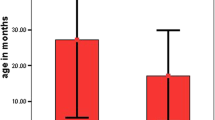Abstract
Background
As adequate therapy for retinoblastoma in young children depends on infiltration of extra-retinal structures, diagnostic modalities play an essential role.
Methods: In this widely extended study, 80 children with retinoblastoma were studied with MRI (standard fat-suppressed Gd-enhanced T1, T2 thin-slice sequences (additionally with small loop surface coil), constructive interference in steady state (CISS) sequence covering the orbita). The images were analysed by two blinded neuroradiologists. Histology was used as the gold standard.
Results: MRI assumed infiltration of extra-retinal structures in 13 of 80 patients of which ten were confirmed by histology. Affected extra-retinal structures were: optic nerve (five, of which two were on CISS and three on T1 with higher image resolution using the surface coil), scleral infiltration (five, of which four on CISS and T1) and ciliary body infiltration (one on CISS and T1). Another 61 enucleated patients did not have any extra-retinal infiltration in histology. The CISS sequence with multiplanar reconstruction was mainly helpful in revealing exact three-dimensional tumour extension with excellent clinical acceptance and pre-surgical planning but T1 fat-suppressed Gd-enhanced images were superior in revealing exact tumour extension.
Conclusion: CISS sequences allow to produce excellent anatomical images and to perform multiplanar reconstruction to better demonstrate tumour extension. However, T1-weighted sequences after contrast application are more sensitive (60 versus 40%) in detecting infiltration of the optic nerve but equal in detecting scleral infiltration.




Similar content being viewed by others
References
Muir KR, Smith H, Parkes SE et al. (1990) Increasing incidence of retinoblastoma? Arch Dis Child 65:915
Singh AD, Shields CL, Shields JA (2000) Prognostic factors in retinoblastoma. J Pediatr Ophthalmol Strabismus 37:134–141 (see also pp. 168–139)
Schueler AO, Hosten N, Bechrakis NE et al. (2003) High resolution magnetic resonance imaging of retinoblastoma. Br J Ophthalmol 87:330–335
Abramson DH, Schefler AC (2004) Transpupillary thermotherapy as initial treatment for small intraocular retinoblastoma: technique and predictors of success. Ophthalmology 111:984–991
Bornfeld N, Schuler A, Bechrakis N et al. (1997) Preliminary results of primary chemotherapy in retinoblastoma. Klin Padiatr 209:216–221
Murphree AL, Villablanca JG, Deegan WF III et al. (1996) Chemotherapy plus local treatment in the management of intraocular retinoblastoma. Arch Ophthalmol 114:1348–1356
Shields CL, Shelil A, Cater J et al. (2003) Development of new retinoblastomas after 6 cycles of chemoreduction for retinoblastoma in 162 eyes of 106 consecutive patients. Arch Ophthalmol 121:1571–1576
Shields CL, Shields JA, De Potter P et al. (1993) Plaque radiotherapy for retinoblastoma. Int Ophthalmol Clin 33:107–118
Schueler AO, Jurklies C, Heimann H et al. (2003) Thermochemotherapy in hereditary retinoblastoma. Br J Ophthalmol 87:90–95
Toma NM, Hungerford JL, Plowman PN et al. (1995) External beam radiotherapy for retinoblastoma: II. Lens sparing technique. Br J Ophthalmol 79:112–117
Kaufman LM, Mafee MF, Song CD (1998) Retinoblastoma and simulating lesions. Role of CT, MR imaging and use of Gd-DTPA contrast enhancement. Radiol Clin N Am 36:1101–1117
Wycliffe ND, Mafee MF (1999) Magnetic resonance imaging in ocular pathology. Top Magn Reson Imaging 10:384–400
Stuckey SL, Harris AJ, Mannolini SM (1996) Detection of acoustic schwannoma: use of constructive interference in the steady state three-dimensional MR. AJNR Am J Neuroradiol 17:1219–1225
Diamantopoulos II, Ludman CN, Martel AL et al. (1999) Magnetic resonance imaging virtual endoscopy of the labyrinth. Am J Otol 20:748–751
Yousry I, Camelio S, Schmid UD et al (2000) Visualization of cranial nerves I–XII: value of 3D CISS and T2-weighted FSE sequences. Eur Radiol 10:1061–1067
Held P, Frund R, Seitz J, et al. (2000) Comparison of a T2* w. 3D CISS and a T2 w. 3D turbo spin echo sequence for the anatomical study of facial and vestibulocochlear nerves. J Neuroradiol 27:173–178
McCaffery S, Simon EM, Fischbein NJ et al. (2002) Three-dimensional high-resolution magnetic resonance imaging of ocular and orbital malignancies. Arch Ophthalmol 120:747–754
O’Brien JM (2001) Retinoblastoma: clinical presentation and the role of neuroimaging. Am J Neuroradiol 22:426–428
Bornfeld N (1999) (Retinoblastoma). Klin Monatsbl Augenheilkd 214:aA10–11
Suzuki S, Kaneko A (2004) Management of intraocular retinoblastoma and ocular prognosis. Int J Clin Oncol 9:1–6
Smith MM, Strottmann JM (2001) Imaging of the optic nerve and visual pathways. Semin Ultrasound CT MR 22:473–487
Breslau J, Dalley RW, Tsuruda JS et al. (1995) Phased-array surface coil MR of the orbits and optic nerves. Am J Neuroradiol 16:1247–1251
Author information
Authors and Affiliations
Corresponding author
Rights and permissions
About this article
Cite this article
Gizewski, E.R., Wanke, I., Jurklies, C. et al. T1 Gd-enhanced compared with CISS sequences in retinoblastoma: superiority of T1 sequences in evaluation of tumour extension. Neuroradiology 47, 56–61 (2005). https://doi.org/10.1007/s00234-004-1316-x
Received:
Accepted:
Published:
Issue Date:
DOI: https://doi.org/10.1007/s00234-004-1316-x




